Unmanned aerial vehicle

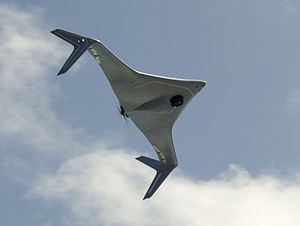


An uncrewed aerial vehicle (UAV), commonly known as a drone, is an aircraft without any human pilot, crew, or passengers on board. UAVs were originally developed through the twentieth century for military missions too "dull, dirty or dangerous"[1] for humans, and by the twenty-first, they had become essential assets to most militaries. As control technologies improved and costs fell, their use expanded to many non-military applications.[2] These include aerial photography, area coverage,[3] precision agriculture, forest fire monitoring,[4] river monitoring,[5][6] environmental monitoring,[7][8][9][10] policing and surveillance, infrastructure inspections, smuggling,[11] product deliveries, entertainment, and drone racing.
Terminology
Many terms are used for aircraft which fly without any persons on board.
The term drone has been used from the early days of aviation, some being applied to remotely flown target aircraft used for practice firing of a battleship's guns, such as the 1920s Fairey Queen and 1930s de Havilland Queen Bee. Later examples included the Airspeed Queen Wasp and Miles Queen Martinet, before ultimate replacement by the GAF Jindivik.[12] The term remains in common use. In addition to the software, autonomous drones also employ a host of advanced technologies that allow them to carry out their missions without human intervention, such as cloud computing, computer vision, artificial intelligence, machine learning, deep learning, and thermal sensors.[13] For recreational uses, an aerial photography drone is an aircraft that has first-person video, autonomous capabilities, or both.[14]
An unmanned aerial vehicle (UAV) is defined as a "powered, aerial vehicle that does not carry a human operator, uses aerodynamic forces to provide vehicle lift, can fly autonomously or be piloted remotely, can be expendable or recoverable, and can carry a lethal or nonlethal payload".[15] UAV is a term that is commonly applied to military use cases.[16] Missiles with warheads are generally not considered UAVs because the vehicle itself is a munition, but certain types of propeller-based missile are often called "kamikaze drones" by the public and media. Also, the relation of UAVs to remote controlled model aircraft is unclear,[citation needed] UAVs may or may not include remote-controlled model aircraft. Some jurisdictions base their definition on size or weight; however, the US FAA defines any uncrewed flying craft as a UAV regardless of size. [citation needed] A similar term is remotely piloted aerial vehicle (RPAV).
UAVs or RPAVs can also be seen as a component of an unmanned aircraft system (UAS), which also includes a ground-based controller and a system of communications with the aircraft.[4] The term UAS was adopted by the United States Department of Defense (DoD) and the United States Federal Aviation Administration (FAA) in 2005 according to their Unmanned Aircraft System Roadmap 2005–2030.[17] The International Civil Aviation Organization (ICAO) and the British Civil Aviation Authority adopted this term, also used in the European Union's Single-European-Sky (SES) Air-Traffic-Management (ATM) Research (SESAR Joint Undertaking) roadmap for 2020.[18] This term emphasizes the importance of elements other than the aircraft. It includes elements such as ground control stations, data links and other support equipment. Similar terms are unmanned-aircraft vehicle system (UAVS) and remotely piloted aircraft system (RPAS).[19] Many similar terms are in use. Under new regulations which came into effect 1 June 2019, the term RPAS has been adopted by the Canadian Government to mean "a set of configurable elements consisting of a remotely piloted aircraft, its control station, the command and control links and any other system elements required during flight operation".[20]
Classification types
UAVs may be classified like any other aircraft, according to design configuration such as weight or engine type, maximum flight altitude, degree of operational autonomy, operational role, etc. According to the United States Department of Defense, UAVs are classified into five categories below:[21][22]
| Group: | Group 1 | Group 2 | Group 3 | Group 4 | Group 5 |
|---|---|---|---|---|---|
| Size | Small | Medium | Large | Larger | Largest |
| Max take-off wt | < 20 lb (9.1 kg) |
> 20 & < 55 | > 55 & < 1320 | >1,320 lb (600 kg) |
>1,320 lb (600 kg) |
| Operating altitude | < 1,200 ft (370 m) |
< 3,500 ft (1,100 m) |
< 18,000 ft (5,500 m) |
< 18,000 ft (5,500 m) |
> 18,000 ft (5,500 m) |
| Speed | < 100 kn (190 km/h) |
< 250 kn (460 km/h) |
< 250 kn (460 km/h) |
Any speed | Any speed |
Other classifications of UAVs include:[21]
Range and endurance
There are usually five categories when UAVs are classified by range and endurance:[21]
| Category: | Very close range UAVs | Close range UAVs | Short range UAVs | Medium range UAVs | Long range UAVs |
|---|---|---|---|---|---|
| Range (km): | < 5 | > 5 & < 50 | > 50 & < 150 | > 150 & < 650 | > 650 |
| Endurance (hr): | 0.5 – 0.75 | 1–6 | 8–12 | 12 – 36 or 48 | > 36 or 48 |
Size
There are usually four categories when UAVs are classified by size, with at least one of the dimensions (length or wingspan) meet the following respective limits:[21]
| Category: | Micro/Very small UAVs | Mini/Small UAVs | Medium UAVs | Large UAVs |
|---|---|---|---|---|
| Length/Wingspan: | < 50 cm | > 50 cm & < 2 m | 5 –10 m | > 10 m |
Weight
Based on their weight, drones can be classified into 5 categories—
| Category: | Nano | Micro air vehicles (MAV) | Miniature UAV or Small (SUAV) | Medium UAVs | Large UAVs |
|---|---|---|---|---|---|
| Weight: | < 250 gm | >= 250 gm & <02 Kg | >= 02 Kg & <25 Kg | >= 25 kg & <150 Kg | >=150 kg |
.[23]
Degree of autonomy
Drones could also be classified based on the degree of autonomy in their flight operations. ICAO classifies uncrewed aircraft as either remotely piloted aircraft or fully autonomous.[24] Some UAVs offer intermediate degrees of autonomy. For example, a vehicle may be remotely piloted in most contexts but have an autonomous return-to-base operation. Some aircraft types may optionally fly manned or as UAVs, which may include manned aircraft transformed into uncrewed or Optionally Piloted UAVs (OPVs). The flight of UAVs may operate under remote control by a human operator, as remotely piloted aircraft (RPA), or with various degrees of autonomy, such as autopilot assistance, up to fully autonomous aircraft that have no provision for human intervention.[25][26]
Altitude
Based on the altitude, the following UAV classifications have been used at industry events such as ParcAberporth Unmanned Systems forum:
- Hand-held 2,000 ft (600 m) altitude, about 2 km range
- Close 5,000 ft (1,500 m) altitude, up to 10 km range
- NATO type 10,000 ft (3,000 m) altitude, up to 50 km range
- Tactical 18,000 ft (5,500 m) altitude, about 160 km range
- MALE (medium altitude, long endurance)up to 30,000 ft (9,000 m) and range over 200 km
- HALE (high altitude, long endurance)over 30,000 ft (9,100 m) and indefinite range
- Hypersonic high-speed, supersonic (Mach 1–5) or hypersonic (Mach 5+) 50,000 ft (15,200 m) or suborbital altitude, range over 200 km
- Orbital low Earth orbit (Mach 25+)
- CIS Lunar Earth-Moon transfer
- Computer Assisted Carrier Guidance System (CACGS) for UAVs
Composite criteria
An example of classification based on the composite criteria is U.S. Military's
History

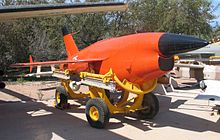
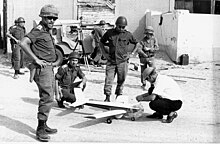
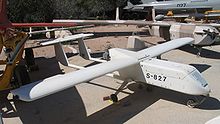
Early drones
The earliest recorded use of an unmanned aerial vehicle for warfighting occurred in July 1849,
The Spanish engineer
Significant development of drones started in the 1900s, and originally focused on providing practice targets for training
The film star and
Soviet researchers experimented with controlling Tupolev TB-1 bombers remotely in the late 1930s.[43]
World War II
In 1940, Denny started the
Postwar period
After World War II development continued in vehicles such as the American
During the War of Attrition (1967–1970) in the Middle East, Israeli intelligence tested the first tactical UAVs installed with reconnaissance cameras, which successfully returned photos from across the Suez Canal. This was the first time that tactical UAVs that could be launched and landed on any short runway (unlike the heavier jet-based UAVs) were developed and tested in battle.[50]
In the 1973 Yom Kippur War, Israel used UAVs as decoys to spur opposing forces into wasting expensive anti-aircraft missiles.[51] After the 1973 Yom Kippur war, a few key people from the team that developed this early UAV joined a small startup company that aimed to develop UAVs into a commercial product, eventually purchased by Tadiran and leading to the development of the first Israeli UAV.[52][pages needed]
In 1973, the U.S. military officially confirmed that they had been using UAVs in Southeast Asia (Vietnam).
During the 1973
Modern UAVs
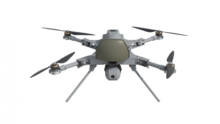
With the maturing and miniaturization of applicable technologies in the 1980s and 1990s, interest in UAVs grew within the higher echelons of the U.S. military. The U.S. funded the CTC or counterterror center within the CIA which sought to fight terrorism with the aid of modernized drone technology.
CAPECON, a European Union project to develop UAVs,[62] ran from 1 May 2002 to 31 December 2005.[63]
As of 2012[update], the
The development of smart technologies and improved electrical-power systems led to a parallel increase in the use of drones for consumer and general aviation activities. As of 2021, quadcopter drones exemplify the widespread popularity of hobby radio-controlled aircraft and toys, however the use of UAVs in commercial and general aviation is limited by a lack of autonomy[clarification needed] and by new regulatory environments which require line-of-sight contact with the pilot.[citation needed]
In 2020, a
Superior drone technology, specifically the

UAVs are also used in NASA missions. The Ingenuity helicopter is an autonomous UAV that operated on Mars from 2021 to 2024. Current the Dragonfly spacecraft is being developed, and is aiming to reach and examine Saturn's moon Titan. Its primary goal is to roam around the surface, expanding the amount of area to be researched previously seen by landers. As a UAV, Dragonfly allows examination of potentially diverse types of soil. The drone is set to launch in 2027, and is estimated to take seven more years to reach the Saturnian system.
Miniaturization is also supporting the development of small UAVs which can be used as individual system or in a fleet offering the possibility to survey large areas, in a relatively small amount of time.[72]
Design
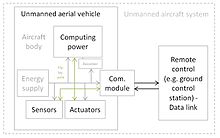
Crewed and uncrewed aircraft of the same type generally have recognizably similar physical components. The main exceptions are the
Small civilian UAVs have no
Control systems for UAVs are often different from crewed craft. For remote human control, a camera and video link almost always replace the cockpit windows; radio-transmitted digital commands replace physical cockpit controls. Autopilot software is used on both crewed and uncrewed aircraft, with varying feature sets.[73][74][75]
Aircraft configuration
UAVs can be designed in different configurations than manned aircraft both because there is no need for a cockpit and its windows, and there is no need to optimize for human comfort, although some UAVs are adapted from piloted examples, or are designed for optionally piloted modes.
For conventional flight the
For uses that require vertical flight or hovering, the tailless quadcopter requires a relatively simple control system and is common for smaller UAVs. Multirotor designs with 6 or more rotors is more common with larger UAVs, where redundancy is prioritized.[76][77]
Propulsion
Traditional
Besides the traditional piston engine, the
Small drones mostly use
Ornithopters – wing propulsion
Flapping-wing ornithopters, imitating birds or insects, have been flown as microUAVs. Their inherent stealth recommends them for spy missions.
Sub-1g microUAVs inspired by flies, albeit using a power tether, have been able to "land" on vertical surfaces.[79] Other projects mimic the flight of beetles and other insects.[80]
Computer control systems

UAV computing capability followed the advances of computing technology, beginning with analog controls and evolving into microcontrollers, then system-on-a-chip (SOC) and single-board computers (SBC).
System hardware for small UAVs is often called the flight controller (FC), flight controller board (FCB) or autopilot. Common UAV-systems control hardware typically incorporate a primary microprocessor, a secondary or failsafe processor, and sensors such as accelerometers, gyroscopes, magnetometers, and barometers into a single module.
Architecture
Sensors
Position and movement sensors give information about the aircraft state. Exteroceptive sensors deal with external information like distance measurements, while exproprioceptive ones correlate internal and external states.[81]
Non-cooperative sensors are able to detect targets autonomously so they are used for separation assurance and collision avoidance.[82]
Degrees of freedom (DOF) refers to both the amount and quality of sensors on board: 6 DOF implies 3-axis gyroscopes and accelerometers (a typical inertial measurement unit – IMU), 9 DOF refers to an IMU plus a compass, 10 DOF adds a barometer and 11 DOF usually adds a GPS receiver.[83]
In addition to the navigation sensors, the UAV (or UAS) can be also equipped with monitoring devices such as: RGB, multispectral, hyper-spectral cameras or LiDAR, which may allow providing specific measurements or observations.[84]
Actuators
UAV actuators include digital electronic speed controllers (which control the RPM of the motors) linked to motors/engines and propellers, servomotors (for planes and helicopters mostly), weapons, payload actuators, LEDs and speakers.
Software
This section needs to be updated. (February 2022) |
The software running on a UAV is called the autopilot or the flight stack. The purpose of the flight stack is to fly the mission autonomously or with remote-pilot input. An autopilot achieves this by obtaining data from sensors, controlling the motors to make progress along a path, and facilitate communications with ground control and mission planning.[85]
UAVs are real-time systems that require high-frequency to changing sensor data. As a result, UAVs rely on single-board computers for their computational needs. Examples of such single-board computers include Raspberry Pis, Beagleboards, etc. shielded with NavIO, PXFMini, etc. or designed from scratch such as NuttX, preemptive-RT Linux, Xenomai, Orocos-Robot Operating System or DDS-ROS 2.0.
| Layer | Requirement | Operations | Example |
|---|---|---|---|
| Firmware | Time-critical | From machine code to processor execution, memory access | ArduCopter-v1, PX4 |
| Middleware | Time-critical | Flight control, navigation, radio management | PX4, Cleanflight, ArduPilot |
| Operating system | Computer-intensive | Optical flow, obstacle avoidance, SLAM, decision-making | ROS, Nuttx, Linux distributions, Microsoft IOT |
Due to the open-source nature of UAV software, they can be customized to fit specific applications. For example, researchers from the Technical University of Košice have replaced the default control algorithm of the PX4 autopilot.[86] This flexibility and collaborative effort has led to a large number of different open-source stacks, some of which are forked from others, such as CleanFlight, which is forked from BaseFlight and from which three other stacks are forked.
Loop principles
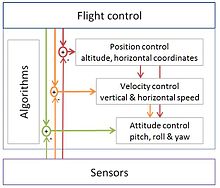
UAVs employ open-loop, closed-loop or hybrid control architectures.
- Open loop – This type provides a positive control signal (faster, slower, left, right, up, down) without incorporating feedback from sensor data.
- PID controller is common. Sometimes, feedforward is employed, transferring the need to close the loop further.[87]
Communications
UAVs use a radio for control and exchange of video and other data. Early UAVs had only narrowband uplink. Downlinks came later. These bi-directional narrowband radio links carried command and control (C&C) and telemetry data about the status of aircraft systems to the remote operator.
In most modern UAV applications, video transmission is required. So instead of having separate links for C&C, telemetry and video traffic, a
The radio signal from the operator side can be issued from either:
- Ground control – a human operating a radio transmitter/receiver, a smartphone, a tablet, a computer, or the original meaning of a military ground control station (GCS).
- Remote network system, such as satellite duplex data links for some military powers. Downstream digital video over mobile networks has also entered consumer markets, while direct UAV control uplink over the cellular mesh and LTE have been demonstrated and are in trials.[88]
- Another aircraft, serving as a relay or mobile control station – military manned-unmanned teaming (MUM-T).[89]
Modern networking standards have explicitly considered drones and therefore include optimizations. The 5G standard has mandated reduced user plane latency to 1ms while using ultra-reliable and low-latency communications.[90]
UAV-to-UAV coordination supported by Remote ID communication technology. Remote ID messages (containing the UAV coordinates) are broadcast and can be used for collision-free navigation.[91]
Autonomy
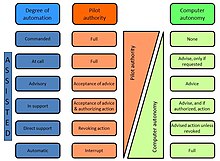
The level of autonomy in UAVs varies widely. UAV manufacturers often build in specific autonomous operations, such as:[92]
- Self-level: attitude stabilization on the pitch and roll axes.
- Altitude hold: The aircraft maintains its altitude using barometric pressure and/or GPS data.
- Hover/position hold: Keep level pitch and roll, stable yaw heading and altitude while maintaining position using GNSSor inertial sensors.
- Headless mode: Pitch control relative to the position of the pilot rather than relative to the vehicle's axes.
- Care-free: automatic roll and yaw control while moving horizontally
- Take-off and landing (using a variety of aircraft or ground-based sensors and systems; see also "autoland")
- Failsafe: automatic landing or return-to-home upon loss of control signal
- Return-to-home: Fly back to the point of takeoff (often gaining altitude first to avoid possible intervening obstructions such as trees or buildings).
- Follow-me: Maintain relative position to a moving pilot or other object using GNSS, image recognitionor homing beacon.
- GPS waypoint navigation: Using GNSS to navigate to an intermediate location on a travel path.
- Orbit around an object: Similar to Follow-me but continuously circle a target.
- Pre-programmed aerobatics (such as rolls and loops)
One approach to quantifying autonomous capabilities is based on OODA terminology, as suggested by a 2002 US Air Force Research Laboratory report, and used in the table on the right.[93]

Full autonomy is available for specific tasks, such as
Other functions available or under development include; collective flight, real-time collision avoidance, wall following, corridor centring, simultaneous localization and mapping and swarming, cognitive radio and machine learning. In this context, computer vision can play an important role for automatically ensuring flight safety.
Performance considerations
Flight envelope
UAVs can be programmed to perform aggressive maneuvers or landing/perching on inclined surfaces,[95] and then to climb toward better communication spots.[96] Some UAVs can control flight with varying flight modelisation,[97][98] such as VTOL designs.
UAVs can also implement perching on a flat vertical surface.[99]
Endurance

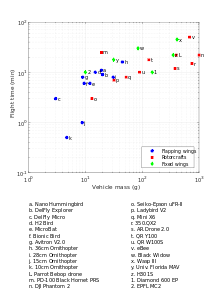
UAV endurance is not constrained by the physiological capabilities of a human pilot.
Because of their small size, low weight, low vibration and high power to weight ratio,
Proper drone cooling is essential for long-term drone endurance. Overheating and subsequent engine failure is the most common cause of drone failure.[100]
Micro air vehicles endurance is so far best achieved with flapping-wing UAVs, followed by planes and multirotors standing last, due to lower Reynolds number.[81]
Solar-electric UAVs, a concept originally championed by the AstroFlight Sunrise in 1974, have achieved flight times of several weeks.
Solar-powered atmospheric satellites ("atmosats") designed for operating at altitudes exceeding 20 km (12 miles, or 60,000 feet) for as long as five years could potentially perform duties more economically and with more versatility than
Electric UAVs powered by microwave power transmission or laser power beaming are other potential endurance solutions.[103]
Another application for a high endurance UAV would be to "stare" at a battlefield for a long interval (ARGUS-IS, Gorgon Stare, Integrated Sensor Is Structure) to record events that could then be played backwards to track battlefield activities.
| UAV | Flight time hours:minutes |
Date | Notes |
|---|---|---|---|
| Boeing Condor | 58:11 | 1989 | The aircraft is currently in the Hiller Aviation Museum. |
| General Atomics Gnat | 40:00 | 1992 | [105][106] |
TAM-5 |
38:52 | 11 August 2003 | Smallest UAV to cross the Atlantic |
QinetiQ Zephyr Solar Electric |
54:00 | September 2007 | [108][109] |
RQ-4 Global Hawk |
33:06 | 22 March 2008 | Set an endurance record for a full-scale, operational uncrewed aircraft.[110] |
QinetiQ Zephyr Solar Electric |
82:37 | 28–31 July 2008 | [111] |
| QinetiQ Zephyr 7 | 336:22 | 9–23 July 2010 | Solar electric powered. Remained aloft for 14 days. Also filed for FAI altitude record of 70,740 ft (21,561 m)[112] |
The delicacy of the British
Reliability
Reliability improvements target all aspects of UAV systems, using resilience engineering and fault tolerance techniques.
Individual reliability covers robustness of flight controllers, to ensure safety without excessive redundancy to minimize cost and weight.[114] Besides, dynamic assessment of flight envelope allows damage-resilient UAVs, using non-linear analysis with ad hoc designed loops or neural networks.[115] UAV software liability is bending toward the design and certifications of crewed avionics software.[116]
Swarm resilience involves maintaining operational capabilities and reconfiguring tasks given unit failures.[117]
Applications
In recent years, autonomous drones have begun to transform various application areas as they can fly beyond visual line of sight (BVLOS)[118] while maximizing production, reducing costs and risks, ensuring site safety, security and regulatory compliance,[119] and protecting the human workforce in times of a pandemic.[120] They can also be used for consumer-related missions like package delivery, as demonstrated by Amazon Prime Air, and critical deliveries of health supplies.
There are numerous civilian, commercial, military, and aerospace applications for UAVs.[2] These include:
- General
- Disaster relief, archeology, conservation of biodiversity and habitat,[121] law enforcement, crime, and terrorism.
- Commercial
- Aerial surveillance, filmmaking,[122] journalism, scientific research, surveying, cargo transport, mining, manufacturing, Forestry, solar farming, thermal energy, ports and agriculture.
Warfare
As of 2020, seventeen countries have armed UAVs, and more than 100 countries use UAVs in a military capacity.[123] The global military UAV market is dominated by companies based in the United States, Turkey,[124][125] China,[126] Israel and Iran.[127] By sale numbers, the US held over 60% military-market share in 2017. Top military UAV manufactures are including General Atomics, Lockheed Martin, Northrop Grumman, Boeing, Baykar,[128][125] TAI, IAIO, CASC and CAIG.[127] China has established and expanded its presence in military UAV market[127] since 2010. Turkey also established and expanded its presence in military UAV market.[124][127][125][128]
Of the 18 countries that are known to have received military drones between 2010 and 2019, the top 12 all purchased their drones from China.[127] According to a report of 2015, Israeli companies mainly focus on small surveillance UAV systems and by quantity of drones, Israel exported 60.7% (2014) of UAV on the market while the United States export 23.9% (2014).[129] Between 2010 and 2014, there were 439 drones exchanged compared to 322 in the five years previous to that, among these only small fraction of overall trade – just 11 (2.5%) of the 439 are armed drones.[129] The US alone operated over 9,000 military UAVs in 2014; among them more than 7000 are RQ-11 Raven miniature UAVs.[130] General Atomics is the dominant manufacturer with the Global Hawk and Predator/Mariner systems product-line.
For intelligence and reconnaissance missions, the inherent stealth of micro UAV flapping-wing ornithopters, imitating birds or insects, offers potential for covert surveillance and makes them difficult targets to bring down.
Unmanned surveillance and reconnaissance aerial vehicle are used for reconnaissance, attack, demining, and target practice.
Following the 2022 Russian invasion of Ukraine a dramatic increase in UAV development took place with Ukraine creating the Brave1 platform to promote rapid development of innovative systems.
Civil
Suppliers

The civilian (commercial and general) drone market is dominated by Chinese companies. Chinese manufacturer
The civil UAV market is relatively new compared to the military one. Companies are emerging in both developed and developing nations at the same time. Many early stage startups have received support and funding from investors as is the case in the United States and by government agencies as is the case in India.[137] Some universities offer research and training programs or degrees.[138] Private entities also provide online and in-person training programs for both recreational and commercial UAV use.[139]
Consumer drones are widely used by military organizations worldwide because of the cost-effective nature of consumer product. In 2018, Israeli military started to use DJI
Entertainment
Drones are also used in nighttime
Drones can also be used for racing, either with or without VR functionality.
Aerial photography
Drones are ideally suited to capturing aerial shots in photography and cinematography, and are widely used for this purpose.[122] Small drones avoid the need for precise coordination between pilot and cameraman, with the same person taking on both roles. However, big drones with professional cine cameras, there is usually a drone pilot and a camera operator who controls camera angle and lens. For example, the AERIGON cinema drone which is used in film production in big blockbuster movies is operated by 2 people.[147] Drones provide access to dangerous, remote or otherwise inaccessible sites.
Environmental Monitoring
UASs or UAVs offer the great advantage for environmental monitoring to generate a new generation of survey at very-high or ultra-high resolution both in space and time. This gives the opportunity to bridge the existing gap between satellite data and field monitoring. This has stimulated a huge number of activities in order to enhance the description of natural and agricultural ecosystems. Most common applications are:
- Topographic surveys[148] for the production of orthomosaics, Digital Surface Model (DSM), 3D Models;
- Monitoring of natural ecosystems for biodiversity monitoring,[149] habitat mapping,[150] detection of invasive alien species[151] and study of ecosystem degradation due to invasive species or disturbances;
- Precision Agriculture[152] which exploits all available technologies including UAV in order to produce more with less (e.g., optimisation of fertilizers, pesticides, irrigation);
- River monitoring several methods have been developed to perform flow monitoring using image velocimetry methods which allow to properly describe the 2D flow velocity fields.[153]
- Structural integrity of any type of structure whether it be a dam, railway or other dangerous, inaccessible or massive locations for building monitoring.[154]
These activities can be carried out with different approaches that include: photogrammetry, SfM, thermography, multispectral images, 3D field scanning, NDVI maps, etc.
Agriculture, forestry and environmental studies
As global demand for food production grows exponentially, resources are depleted, farmland is reduced, and agricultural labor is increasingly in short supply, there is an urgent need for more convenient and smarter agricultural solutions than traditional methods, and the agricultural drone and robotics industry is expected to make progress.[155] Agricultural drones have been used to help build sustainable agriculture all over the world leading to a new generation of agriculture.[156] In this context, there is a proliferation of innovations in both tools and methodologies which allow precise description of vegetation state and also may help to precisely distribute nutrients, pesticides or seeds over a field.[5]
The use of UAVs is also being investigated to help detect and fight wildfires, whether through observation or launching pyrotechnic devices to start backfires.[157]
UAVs are also now widely used to survey wildlife such as nesting seabirds, seals and even wombat burrows.[158]
Law enforcement
Humanitarian Aid
Drones are increasingly finding their application in humanitarian aid and disaster relief, where they are used for a wide range of applications such as delivering food, medicine and essential items to remote areas or image mapping before and following disasters [160]
Safety and security
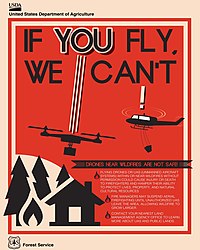
Threats
Nuisance
UAVs can threaten airspace security in numerous ways, including unintentional collisions or other interference with other aircraft, deliberate attacks or by distracting pilots or flight controllers. The first incident of a drone-airplane collision occurred in mid-October 2017 in Quebec City, Canada.[161] The first recorded instance of a drone collision with a hot air balloon occurred on 10 August 2018 in Driggs, Idaho, United States; although there was no significant damage to the balloon nor any injuries to its 3 occupants, the balloon pilot reported the incident to the National Transportation Safety Board, stating that "I hope this incident helps create a conversation of respect for nature, the airspace, and rules and regulations".[162] Unauthorized UAV flights into or near major airports have prompted extended shutdowns of commercial flights.[163]
Drones caused significant disruption at Gatwick Airport during December 2018, needing the deployment of the British Army.[164][165]
In the United States, flying close to a wildfire is punishable by a maximum $25,000 fine. Nonetheless, in 2014 and 2015, firefighting air support in California was hindered on several occasions, including at the
Security vulnerabilities
By 2017, drones were being used to drop contraband into prisons.[170]
The interest in UAVs cyber security has been raised greatly after the Predator UAV video stream hijacking incident in 2009,[171] where Islamic militants used cheap, off-the-shelf equipment to stream video feeds from a UAV. Another risk is the possibility of hijacking or jamming a UAV in flight. Several security researchers have made public some vulnerabilities in commercial UAVs, in some cases even providing full source code or tools to reproduce their attacks.[172] At a workshop on UAVs and privacy in October 2016, researchers from the Federal Trade Commission showed they were able to hack into three different consumer quadcopters and noted that UAV manufacturers can make their UAVs more secure by the basic security measures of encrypting the Wi-Fi signal and adding password protection.[173]
Aggression
UAVs could be loaded with dangerous payloads, and crashed into vulnerable targets. Payloads could include explosives, chemical, radiological or biological hazards. UAVs with generally non-lethal payloads could possibly be hacked and put to malicious purposes. Anti-UAV systems are being developed by states to counter this threat. This is, however, proving difficult. As J. Rogers stated in an interview to A&T "There is a big debate out there at the moment about what the best way is to counter these small UAVs, whether they are used by hobbyists causing a bit of a nuisance or in a more sinister manner by a terrorist actor".[174]
Countermeasures
Counter unmanned air system
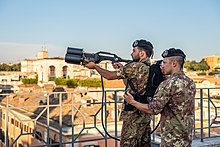

The malicious use of UAVs has led to the development of counter unmanned air system (C-UAS) technologies. Automatic tracking and detection of UAVs from commercial cameras have become accurate thanks to the development of deep learning based machine learning algorithms.[175] It is also possible to automatically identify UAVs across different cameras with different view points and hardware specification with re-identification methods.[176] Commercial systems such as the Aaronia AARTOS have been installed on major international airports.[177][178] Once a UAV is detected, it can be countered with kinetic force (missiles, projectiles or another UAV) or by non-kinetic force (laser, microwaves, communications jamming).[179] Anti-aircraft missile systems such as the Iron Dome are also being enhanced with C-UAS technologies. Utilising a smart UAV swarm to counter one or more hostile UAVs is also proposed.[180]
Regulation
Regulatory bodies around the world are developing unmanned aircraft system traffic management solutions to better integrate UAVs into airspace.[181]
The use of unmanned aerial vehicles is becoming increasingly regulated by the
EU Drone Certification - Class Identification Label
The implementation of the Class Identification Label serves a crucial purpose in the regulation and operation of drones.[186] The label is a verification mechanism designed to confirm that drones within a specific class meet the rigorous standards set by administrations for design and manufacturing.[187] These standards are necessary to ensure the safety and reliability of drones in various industries and applications.
By providing this assurance to customers, the Class Identification Label helps to increase confidence in drone technology and encourages wider adoption across industries. This, in turn, contributes to the growth and development of the drone industry and supports the integration of drones into society.
Export controls
The export of UAVs or technology capable of carrying a 500 kg payload at least 300 km is restricted in many countries by the Missile Technology Control Regime.
See also
- List of unmanned aerial vehicles
- Delivery drone
- Drone in a Box
- International Aerial Robotics Competition
- List of films featuring drones
- MARSS Interceptor
- Micromechanical Flying Insect
- ParcAberporth
- Quadcopter
- Radio-controlled aircraft
- Autonomous aircraft
- Optionally piloted vehicle
- Sypaq Corvo Precision Payload Delivery System
- Satellite Sentinel Project
- Tactical Control System
- UAV ground control station
- Unmanned underwater vehicle
References
Citations
- ^ Tice, Brian P. (Spring 1991). "Unmanned Aerial Vehicles – The Force Multiplier of the 1990s". Airpower Journal. Archived from the original on 24 July 2009. Retrieved 6 June 2013.
When used, UAVs should generally perform missions characterized by the three Ds: dull, dirty, and dangerous.
- ^ a b Alvarado, Ed (3 May 2021). "237 Ways Drone Applications Revolutionize Business". Drone Industry Insights. Archived from the original on 11 May 2021. Retrieved 11 May 2021.
- ^ F. Rekabi-Bana; Hu, J.; T. Krajník; Arvin, F., "Unified Robust Path Planning and Optimal Trajectory Generation for Efficient 3D Area Coverage of Quadrotor UAVs" IEEE Transactions on Intelligent Transportation Systems, 2023.
- ^ a b Hu, J.; Niu, H.; Carrasco, J.; Lennox, B.; Arvin, F., "Fault-tolerant cooperative navigation of networked UAV swarms for forest fire monitoring" Aerospace Science and Technology, 2022.
- ^ OCLC 1329422815. Archivedfrom the original on 27 February 2023. Retrieved 11 January 2023.
- from the original on 12 January 2023. Retrieved 12 January 2023.
- .
- .
- .
- .
- ^ "Drones smuggling porn, drugs to inmates around the world". Fox News. 17 April 2017. Archived from the original on 31 August 2018. Retrieved 17 April 2017.
- ^ Note; the term "drone" refers to the male bee that serves only to fertilize the queen bee, hence the use of the name in reference to the DH Queen Bee aerial target.
- ^ "Drones and Artificial Intelligence". Drone Industry Insights. 28 August 2018. Archived from the original on 17 September 2020. Retrieved 11 April 2020.
- ^ "What is the difference between a drone and an RC plane or helicopter?". Drones Etc. Archived from the original on 17 November 2015. Retrieved 12 October 2015.
- ^ "unmanned aerial vehicle". TheFreeDictionary.com. Archived from the original on 8 January 2015. Retrieved 8 January 2015.
- ^ Guilmartin, John F. "unmanned aerial vehicle". Encyclopedia Britannica. Archived from the original on 29 March 2020. Retrieved 24 March 2020.
- ^ "Unmanned Aircraft Systems Roadmap" (PDF). Archived from the original (PDF) on 2 October 2008.
- ^ "European ATM Master Plan 2015 | SESAR". www.sesarju.eu. Archived from the original on 6 February 2016. Retrieved 3 February 2016.
- ^ "State government gears up for autonomous RPAS mapping". 23 January 2017. Archived from the original on 25 February 2017. Retrieved 1 February 2017.
- ^ "Canadian Aviation Regulations". Government of Canada – Justice Laws Website. 1 June 2019. Archived from the original on 6 January 2022. Retrieved 16 January 2019.
- ^ a b c d "UAV classification". Archived from the original on 23 May 2022. Retrieved 10 June 2022.
- ^ "Eyes of the Army: U.S. Army Roadmap for UAS 2010–2035" (PDF). Archived (PDF) from the original on 18 February 2022. Retrieved 10 June 2022.
- ^ "Nano, micro, small: The different drone types in India & if Jammu-like strike can be averted" Archived 29 June 2021 at the Wayback Machine, ThePrint, 29 June 2021.
- ^ Drones, Percepto (3 January 2019). "The Differences Between UAV, UAS, and Autonomous Drones". Percepto. Archived from the original on 18 February 2020. Retrieved 18 February 2020.
- ^ Cary, Leslie; Coyne, James. "ICAO Unmanned Aircraft Systems (UAS), Circular 328". 2011–2012 UAS Yearbook – UAS: The Global Perspective (PDF). Blyenburgh & Co. pp. 112–115. Archived from the original (PDF) on 4 March 2016. Retrieved 26 February 2022.
- .
- ^ The Encyclopedia of the Arab-Israeli Conflict: A Political, Social, and Military History: A Political, Social, and Military History, ABC-CLIO, 12 May 2008, by Spencer C. Tucker, Priscilla Mary Roberts, pages 1054–55 ISBN
- ^ The Future of Drone Use: Opportunities and Threats from Ethical and Legal Perspectives Archived 27 February 2023 at the Wayback Machine, Asser Press – Springer, chapter by Alan McKenna, page 355
- ISBN 978-1-4738-2997-8. Archivedfrom the original on 27 February 2023. Retrieved 19 August 2019.
- ISBN 978-0-19-028959-1.
- ^ Naval Aviation in the First World War: Its Impact and Influence, R. D. Layman, page 56
- ISBN 978-0-253-02339-1. Archivedfrom the original on 27 February 2023. Retrieved 26 October 2019.
- ISBN 978-1-85109-488-2. Archivedfrom the original on 27 February 2023. Retrieved 19 August 2019.
- ISBN 978-0-8018-6442-1.
- (PDF) from the original on 6 December 2017. Retrieved 12 July 2018.
- ISBN 0-471-71814-9, p. 97.
- ^ Randy Alfred, "Nov. 7, 1905: Remote Control Wows Public", Wired, 7 November 2011.
- ISBN 978-0-262-02922-3.
- ^ a b c Taylor, John W. R.. Jane's Pocket Book of Remotely Piloted Vehicles.
- ^ Professor A. M. Low FLIGHT, 3 October 1952 page 436 "The First Guided Missile"
- U.S. Army. Archived from the original(PDF) on 22 September 2018. Retrieved 6 March 2011.
- ^ Says, Robert Kanyike (21 May 2012). "History of U.S. Drones". Archived from the original on 26 September 2019. Retrieved 17 February 2014.
- ISBN 9781557507709. Archivedfrom the original on 27 February 2023. Retrieved 18 December 2021.
Experiments with a pilotless drone version of the TB-1 controlled by radio from other aircraft started in 1935 and continued until 1939.
- ISBN 9780262029223.
- ^ Wagner 1982, p. xi.
- ^ Wagner 1982, p. xi, xii.
- ^ Wagner 1982, p. xii.
- ^ Wagner 1982, p. 79.
- ^ Wagner 1982, p. 78, 79.
- ISBN 9781782004318. Retrieved 25 October 2015.]
The War of Attrition was also notable for the first use of UAVs, or unmanned aerial vehicles, carrying reconnaissance cameras in combat.
[permanent dead link - ISBN 9789382573807. Archivedfrom the original on 27 February 2023. Retrieved 25 October 2015.
During the Yom Kippur War the Israelis used Teledyne Ryan 124 R RPVs along with the home-grown Scout and Mastiff UAVs for reconnaissance, surveillance, and as decoys to draw fire from Arab SAMs. This resulted in Arab forces expending costly and scarce missiles on inappropriate targets [...].
- ISBN 9780060013998.
- ^ Wagner 1982, p. 202.
- ^ Wagner 1982, p. 200, 212.
- ^ a b Wagner 1982, p. 208.
- ^ "A Brief History of UAVs". Howstuffworks.com. 22 July 2008. Archived from the original on 22 May 2013. Retrieved 8 January 2015.
- ^ "Russia Buys A Bunch of Israeli UAVs". Strategypage.com. Archived from the original on 26 October 2013. Retrieved 8 January 2015.
- ^ Azoulai, Yuval (24 October 2011). "Unmanned combat vehicles shaping future warfare". Globes. Archived from the original on 3 December 2013. Retrieved 8 January 2015.
- ^ Levinson, Charles (13 January 2010). "Israeli Robots Remake Battlefield". The Wall Street Journal. p. A10. Archived from the original on 13 March 2020. Retrieved 13 January 2010.
- ISBN 978-3-540-97161-0.
- S2CID 154927243.
- ^ Z. Goraj; A. Frydrychewicz; R. Świtkiewicz; B. Hernik; J. Gadomski; T. Goetzendorf-Grabowski; M. Figat; St Suchodolski; W. Chajec. report (PDF). Bulletin of the Polish Academy of Sciences, Technical Sciences, Volume 52. Number 3, 2004. Archived (PDF) from the original on 4 March 2016. Retrieved 9 December 2015.
- ^ Community Research and Development Information Service. Civil uav application and economic effectiveness of potential configuration solutions. published by the Publications Office of the European Union. Archived from the original on 29 January 2016. Retrieved 9 December 2015.
- ^ Ackerman, Spencer; Shachtman, Noah (9 January 2012). "Almost 1 in 3 U.S. Warplanes Is a Robot". WIRED. Archived from the original on 23 March 2020. Retrieved 8 January 2015.
- ^ a b Singer, Peter W. "A Revolution Once More: Unmanned Systems and the Middle East" Archived 6 August 2011 at the Wayback Machine, The Brookings Institution Archived 26 January 2018 at the Wayback Machine, November 2009.
- ^ Radsan, AJ; Murphy (2011). "Measure Twice, Shoot Once: Higher Care for Cia-Targeted Killing". Univ. Ill. Law Rev.:1201–1241.
- ^ Sayler (2015)
- ^ Franke, Ulrike Esther ["The global diffusion of unmanned aerial vehicles (UAVs) or 'drones'"], in Mike Aaronson (ed) Precision Strike Warfare and International Intervention, Routledge 2015.
- ^ Hambling, David. "Drones may have attacked humans fully autonomously for the first time". New Scientist. Archived from the original on 30 July 2021. Retrieved 30 May 2021.
- ^ "Killer drone 'hunted down a human target' without being told to". New York Post. 29 May 2021. Archived from the original on 30 July 2021. Retrieved 30 May 2021.
- ^ Forestier-Walker, Robin (13 October 2020). "Nagorno-Karabakh: New weapons for an old conflict spell danger". Al Jazeera. Archived from the original on 13 October 2020. Retrieved 18 December 2021.
[...] battlefield videos and the known military capabilities of the two warring sides suggest Azerbaijan has the technological advantage, especially with its combat drones purchased from Israel and Turkey.
- from the original on 29 December 2022. Retrieved 11 January 2023.
- ^ "Design, Simulation and New Applications of Unmanned Aerial Vehicles". www.mdpi.com. Retrieved 24 March 2023.
- ^ Nagel, Huub; Bondt, Geert; Custers, Bart; Vergouw, Bas (16 July 2016). "Drone Technology: Types, Payloads, Applications, Frequency Spectrum Issues and Future Developments". The Future of Drone Use.
- ^ da Silva, F.B; Scott, S.D; Cummings, M.L (December 2007). "Design Methodology for Unmannded Aerial Vehicle (UAV) Team Coordination" (PDF). Design Methodology for Unmannded Aerial Vehicle (UAV) Team Coordination.
- PMID 23483997.
- PMID 23483997.
- ^ "Model airplane history-maker Maynard Hill dies at the age of 85". The Washington Post. Archived from the original on 4 July 2018. Retrieved 17 May 2018.
- S2CID 12799012, archived from the original(PDF) on 16 April 2016
- ^ Sarah Knapton (29 March 2016). "Giant remote-controlled beetles and 'biobot' insects could replace drones". The Telegraph. Archived from the original on 1 April 2016.
- ^ from the original on 26 October 2019. Retrieved 26 October 2019.
- .
- ^ "Arduino Playground – WhatIsDegreesOfFreedom6DOF9DOF10DOF11DOF". playground.arduino.cc. Archived from the original on 18 February 2016. Retrieved 4 February 2016.
- ISSN 2072-4292.
- PMID 30225206.
- from the original on 27 February 2023. Retrieved 8 October 2020.
- ^ Pierre-Jean Bristeau; François Callou; David Vissière; Nicolas Petit (2011). "The Navigation and Control technology inside the AR.Drone micro UAV" (PDF). IFAC World Congress. Archived (PDF) from the original on 27 February 2023. Retrieved 4 February 2016.
- ^ "Cellular enables safer drone deployments". Qualcomm. Archived from the original on 9 May 2018. Retrieved 9 May 2018.
- ^ "Identifying Critical Manned-Unmanned Teaming Skills for Unmanned Aircraft System Operators" (PDF). U.S. Army Research Institute for the Behavioral and Social Sciences. September 2012. Archived (PDF) from the original on 6 February 2016.
- ^ "Minimum requirements related to technical performance for IMT-2020 radio interface(s)". www.itu.int. Archived from the original on 6 August 2020. Retrieved 8 October 2020.
- ISBN 979-8-3503-3357-2.
- ^ "Automated Vehicles for Safety | NHTSA". www.nhtsa.gov. Archived from the original on 7 October 2021. Retrieved 8 October 2021.
- ^ Clough, Bruce (August 2002). "Metrics, Schmetrics! How The Heck Do You Determine A UAV's Autonomy Anyway?". US Air Force Research Laboratory. Archived from the original on 24 September 2020.
- from the original on 20 January 2016. Retrieved 3 February 2016.
- ^ "Teaching tiny drones how to fly themselves". Ars Technica. 27 November 2012. Archived from the original on 5 February 2016. Retrieved 4 February 2016.
- ^ "Biomimetics and Dextrous Manipulation Lab – MultiModalRobots". bdml.stanford.edu. Archived from the original on 23 March 2016. Retrieved 21 March 2016.
- ^ D'Andrea, Raffaello (11 June 2013). "The astounding athletic power of quadcopters". www.ted.com. Archived from the original on 5 February 2016. Retrieved 4 February 2016.
- .
- ^ "The device, designed for landing UAV helicopter type on a flat vertical surface". patents.google.com. Archived from the original on 7 March 2017. Retrieved 6 November 2016.
- ^ "The Importance of Proper Cooling and Airflow for Optimal Drone Performance". Pelonis Technologies. Archived from the original on 22 June 2018. Retrieved 22 June 2018.
- ^ "Flying on Hydrogen: Georgia Tech Researchers Use Fuel Cells to Power Unmanned Aerial Vehicle | Georgia Tech Research Institute". www.gtri.gatech.edu. Archived from the original on 3 February 2016. Retrieved 4 February 2016.
- ^ "Hydrogen-powered Hycopter quadcopter could fly for 4 hours at a time". www.gizmag.com. 20 May 2015. Archived from the original on 4 February 2016. Retrieved 4 February 2016.
- ^ Gibbs, Yvonne (31 March 2015). "NASA Armstrong Fact Sheet: Beamed Laser Power for UAVs". NASA. Archived from the original on 5 April 2019. Retrieved 22 June 2018.
- ^ Vertical Challenge: "Monsters of the sky" (PDF), archived from the original (PDF) on 11 September 2013
- ^ "General Atomics Gnat". Designation-systems.net. Archived from the original on 11 December 2008. Retrieved 8 January 2015.
- ^ "UAV Notes". Archived from the original on 30 July 2013.
- ^ "Trans atlantic Model". Tam.plannet21.com. Archived from the original on 22 May 2016. Retrieved 8 January 2015.
- ^ "QinetiQ's Zephyr UAV exceeds official world record for longest duration unmanned flight" (Press release). QinetiQ. 10 September 2007. Archived from the original on 23 April 2011.
- ^ Simonite, Tom. "New Scientist Technology Blog: Solar plane en route to everlasting flight". New Scientist. Archived from the original on 2 April 2015. Retrieved 8 January 2015.
- ^ "Northrop Grumman's Global Hawk Unmanned Aircraft Sets 33-Hour Flight Endurance Record". Spacewar.com. Archived from the original on 1 July 2013. Retrieved 27 August 2013.
- ^ "QinetiQ's Zephyr UAV flies for three and a half days to set unofficial world record for longest duration unmanned flight" (Press release). QinetiQ. 24 August 2008. Archived from the original on 24 May 2011.
- ^ "QinetiQ files for three world records for its Zephyr Solar powered UAV". QinetiQ (Press release). 24 August 2010. Archived from the original on 24 September 2010.
- ^ MacDonald, Alistair (14 July 2023). "Drones Reach Stratospheric Heights in Race to Fly Higher, Longer". Wall Street Journal – via www.wsj.com.
- ^ Boniol (December 2014). "Towards Modular and Certified Avionics for UAV" (PDF). Aerospacelab Journal. Archived (PDF) from the original on 4 February 2016. Retrieved 4 February 2016.
- ^ D. Boskovic and Knoebel (2009). "A Comparison Study of Several Adaptive Control Strategies for Resilient Flight Control" (PDF). AIAA Guidance, Navigation andControl Conference. Archived from the original (PDF) on 4 February 2016.
- ^ Atkins. "Certifiable Autonomous Flight Management for Unmanned Aircraft Systems". University of Michigan. Archived from the original on 5 March 2017. Retrieved 4 February 2016.
- ^ Subhav Pradhan; William Otte; Abhishek Dubey; Aniruddha Gokhale; Gabor Karsai (2013). "Key Considerations for a Resilient and Autonomous Deployment and Configuration Infrastructure for Cyber-Physical Systems" (PDF). Dept. of Electrical Engineering and Computer Science Vanderbilt University, Nashville. Archived (PDF) from the original on 4 February 2016. Retrieved 4 February 2016.
- ^ "How Autonomous Drone Flights Will Go Beyond Line of Sight". Nanalyze. 31 December 2019. Archived from the original on 20 May 2020. Retrieved 16 April 2020.
- ^ McNabb, Miriam (28 February 2020). "Drones Get the Lights Back on Faster for Florida Communities". DRONELIFE. Archived from the original on 12 March 2020. Retrieved 16 April 2020.
- ^ Peck, Abe (19 March 2020). "Coronavirus Spurs Percepto's Drone-in-a-Box Surveillance Solution". Inside Unmanned Systems. Archived from the original on 24 March 2020. Retrieved 16 April 2020.
- from the original on 13 October 2022. Retrieved 13 October 2022.
- ^ from the original on 3 November 2022. Retrieved 3 November 2022.
- .
- ^ a b "Strengthening Turkish Policy on Drone Exports". Carnegie Endowment for International. Archived from the original on 23 March 2022. Retrieved 17 March 2022.
- ^ a b c "Turkey's defense industry targets more than $4 billion in exports this year: Official". Hürriyet Daily News. 6 March 2022. Archived from the original on 17 March 2022. Retrieved 17 March 2022.
- ^ "Combat drones in China are coming to a conflict near you". www.intelligent-aerospace.com. 19 March 2021. Archived from the original on 7 June 2021. Retrieved 7 June 2021.
- ^ a b c d e "Market for Military Drones will Surge". 27 October 2016. Archived from the original on 19 February 2018. Retrieved 19 February 2018.
- ^ a b "Turkish defence industry grows as Akinci UCAV signs first export deal". TRTWORLD. 23 January 2022. Archived from the original on 30 January 2022. Retrieved 17 March 2022.
- ^ a b Arnett, George (16 March 2015). "The numbers behind the worldwide trade in UAVs". The Guardian. Archived from the original on 19 December 2016. Retrieved 13 December 2016.
- ^ "Pentagon Plans for Cuts to Drone Budgets". DoD Buzz. 2 January 2014. Archived from the original on 8 January 2015. Retrieved 17 March 2022.
- ^ Bateman, Joshua (1 September 2017). "China drone maker DJI: Alone atop the unmanned skies". News Ledge. Archived from the original on 19 February 2018. Retrieved 19 February 2018.
- from the original on 29 January 2020. Retrieved 17 November 2020.
- ^ Miller, Maggie (8 October 2020). "DOJ bans use of grant funds for certain foreign-made drones". The Hill. Archived from the original on 28 November 2020. Retrieved 17 November 2020.
- ^ "DJI market share: here's exactly how rapidly it has grown in just a few years". Emberify Blog. 18 September 2018. Archived from the original on 24 September 2018. Retrieved 18 September 2018.
- ^ "UAS by the Numbers". www.faa.gov. Archived from the original on 17 May 2021. Retrieved 24 May 2021.
- ^ "Consumer Drones By the Numbers in 2018 and Beyond | News Ledge". News Ledge. 4 April 2017. Archived from the original on 14 October 2018. Retrieved 13 October 2018.
- ^ "Skylark Drones set to raise its first round of funding to boost expansion". 14 September 2015. Archived from the original on 14 September 2016. Retrieved 28 August 2016.
- from the original on 13 February 2016. Retrieved 4 February 2016.
- ^ "Drone Training Courses – The Complete List". Drone Business Marketer. Archived from the original on 16 November 2016. Retrieved 1 December 2016.
- ^ "IDF buying mass-market DJI drones". Jane's 360. Archived from the original on 11 December 2017.
- ISSN 1091-2339. Archived from the originalon 17 April 2018. Retrieved 2 June 2023.
- ^ "DJI Won the Drone Wars, and Now It's Paying the Price". Bloomberg. 26 March 2020. Archived from the original on 19 November 2020. Retrieved 18 November 2020.
- ^ "大疆创新与新疆自治区公安厅结为警用无人机战略合作伙伴". YouUAV.com. 24 December 2017. Archived from the original on 18 December 2020. Retrieved 18 November 2020.
- ^ "Drone Light Shows Powered by Intel". Intel. Archived from the original on 23 June 2021. Retrieved 28 June 2021.
- ^ Hirsch, Lauren (1 July 2023). "Fireworks Have a New Competitor: Drones". The New York Times. Retrieved 10 August 2023.
- ^ "Fireworks and Drones Combine to Create Amazing Long Exposure Images". Moss and Fog. 1 May 2023. Retrieved 10 August 2023.
- ^ "AERIGON cinema drone (UAV) pioneering in film production". Archived from the original on 26 August 2021. Retrieved 26 August 2021.
- S2CID 56307390.
- from the original on 27 February 2023. Retrieved 12 January 2023.
- from the original on 12 January 2023. Retrieved 12 January 2023.
- S2CID 265016887.
- from the original on 27 February 2023. Retrieved 12 January 2023.
- from the original on 12 January 2023. Retrieved 12 January 2023.
- ISSN 2504-446X.
- ^ "Global Agriculture Drones and Robots Market Analysis & Forecast, 2018-2028 - ResearchAndMarkets.com". finance.yahoo.com. Archived from the original on 7 July 2019. Retrieved 23 May 2019.
- ^ "Africa Farming Problems Aided With Drone Technology". Drone Addicts. 12 March 2018. Archived from the original on 29 June 2018. Retrieved 23 May 2019.
- ^ "Drones That Launch Flaming Balls Are Being Tested To Help Fight Wildfires". NPR.org. Archived from the original on 25 April 2018. Retrieved 5 April 2018.
- ^ Old JM, Lin S H, Franklin MJM (2019). Mapping out bare-nosed wombat (Vombatus ursinus) burrows with the use of a drone. BMC Ecology. 19:39. DOI: 10.1186/s12898-019-0257-5
- ISBN 9781508145028. Archivedfrom the original on 27 February 2023. Retrieved 20 February 2020.
- ^ Sindi & Zarei (15 September 2023). "Drones in humanitarian aid – Can they be a game-changer?".
- ^ Dent, Steve (16 October 2017). "Drone hits a commercial plane for the first time in Canada". Engadget. Archived from the original on 16 October 2017. Retrieved 16 October 2017.
- ^ Tellman, Julie (28 September 2018). "First-ever recorded drone-hot air balloon collision prompts safety conversation". Teton Valley News. Boise, Idaho, United States: Boise Post-Register. Archived from the original on 3 October 2018. Retrieved 3 October 2018.
- ProQuest 2171135630. Archivedfrom the original on 27 June 2020. Retrieved 28 June 2020.
- ^ Halon, Eytan (21 December 2018). "Israeli anti-drone technology brings an end to Gatwick Airport chaos – International news – Jerusalem Post". jpost.com. Archived from the original on 22 December 2018. Retrieved 22 December 2018.
- ^ Matthew Weaver; Damien Gayle; Patrick Greenfield; Frances Perraudin (20 December 2018). "Military called in to help with Gatwick drone crisis". The Guardian. Archived from the original on 22 December 2018. Retrieved 22 December 2018.
- ^ "In The Heat of the Moment, Drones Are Getting in the Way of Firefighters". NPR.org. Archived from the original on 5 March 2018. Retrieved 5 April 2018.
- ^ Michael Martinez; Paul Vercammen; Ben Brumfield (18 July 2015). "Drones visit California wildfire, angering firefighters". CNN. Archived from the original on 8 November 2016. Retrieved 22 August 2016.
- ^ Medina, Jennifer (19 July 2015). "Chasing Video With Drones, Hobbyists Imperil California Firefighting Efforts". The New York Times. Archived from the original on 21 July 2015 – via NYTimes.com.
- ^ Rocha, Veronica (21 July 2015). "Attack on the drones: Legislation could allow California firefighters to take them down". Archived from the original on 28 August 2016. Retrieved 22 August 2016 – via LA Times.
- ^ "Prisons Work To Keep Out Drug-Smuggling Drones". NPR.org. Archived from the original on 19 January 2018. Retrieved 19 January 2018.
- ^ Mike Mount; Elaine Quijano. "Iraqi insurgents hacked Predator drone feeds, U.S. official indicates". CNN.com. Archived from the original on 5 March 2017. Retrieved 6 December 2016.
- ^ Walters, Sander (29 October 2016). "How Can Drones Be Hacked? The updated list of vulnerable drones & attack tools". Medium. Archived from the original on 23 July 2018. Retrieved 6 December 2016.
- ^ Glaser, April (4 January 2017). "The U.S. government showed just how easy it is to hack drones made by Parrot, DBPower and Cheerson". Recode. Archived from the original on 5 January 2017. Retrieved 6 January 2017.
- ^ "Anti-drone technology to be test flown on UK base amid terror fears". 6 March 2017. Archived from the original on 7 May 2017. Retrieved 9 May 2017.
- arXiv:2103.13933.
- ISBN 978-989-758-555-5.
- ^ "Heathrow picks C-UAS to combat drone disruption". Archived from the original on 9 November 2019. Retrieved 13 March 2019.
- ^ "Muscat International Airport to install USD10 million Aaronia counter-UAS system". 21 January 2019. Archived from the original on 9 November 2019. Retrieved 21 January 2019.
- ^ Grand-Clément, Sarah; Bajon, Theò (19 October 2022). "Uncrewed Aerial Systems: A Primer". United Nations Institute for Disarmament Research. Archived from the original on 5 January 2023. Retrieved 5 January 2023.
{{cite journal}}: CS1 maint: bot: original URL status unknown (link) - S2CID 232240581.
- ^ "What is unmanned traffic management?". Airbus. Archived from the original on 8 February 2021. Retrieved 28 January 2021.
- ^ Cary, Leslie; Coyne, James. "ICAO Unmanned Aircraft Systems (UAS), Circular 328". 2011–2012 UAS Yearbook – UAS: The Global Perspective (PDF). Blyenburgh & Co. pp. 112–115. Archived from the original (PDF) on 4 March 2016. Retrieved 26 February 2022.
- ^ Boedecker, Hendrik. "The 2021 Drone Regulation – What is new? What is planned?". Drone Industry Insights. Archived from the original on 17 May 2021. Retrieved 17 May 2021.
- ^ "UAS Remote Identification Overview". www.faa.gov. Archived from the original on 27 May 2021. Retrieved 29 May 2021.
- ^ "FAA Legal Battle – Challenging Remote ID". RaceDayQuads. Archived from the original on 27 May 2021. Retrieved 29 May 2021.
- ^ "UAS Class Label". www.eudronport.com. August 2022. Archived from the original on 5 October 2022. Retrieved 21 February 2023.
- ^ "Official Journal of the European Union". www.eur-lex.europa.eu. Archived from the original on 1 November 2020. Retrieved 20 February 2023.
Bibliography
- Axe, David. Drone War Vietnam. Pen & Sword, Military. Great Britain. (2021). ISBN 978 1 52677 026 4
- Sayler, Kelley (June 2015). "A world of proliferated drones: a technology primer" (PDF). Center for a New American Security. Archived from the original (PDF) on 6 March 2016.
- Wagner, William (1982), Lightning Bugs and other Reconnaissance Drones; The can-do story of Ryan's unmanned spy planes, Armed Forces Journal International : Aero Publishers, ISBN 978-0-8168-6654-0
Further reading
- Cahill, Bill (April 2022). "Lightning Bugs & Buffalo Hunters: The Ryan Model 147 Drone in Vietnam". The Aviation Historian (39): 18–27. ISSN 2051-1930.
- Hill, J., & Rogers, A. (2014). The rise of the drones: From The Great War to Gaza. Vancouver Island University Arts & Humanities Colloquium Series.
- Javier Garcia-Bernardoa; Peter Sheridan Dodds; Neil F. Johnson (2016). "Quantitative patterns in drone wars" (PDF). Science direct. Archived from the original (PDF) on 6 February 2016.
- Rogers, A., & Hill, J. (2014). Unmanned: Drone warfare and global security. Between the Lines. ISBN 9781771131544
External links
- How Intelligent Drones Are Shaping the Future of Warfare Archived 2 May 2018 at the Wayback Machine, Rolling Stone Magazine
